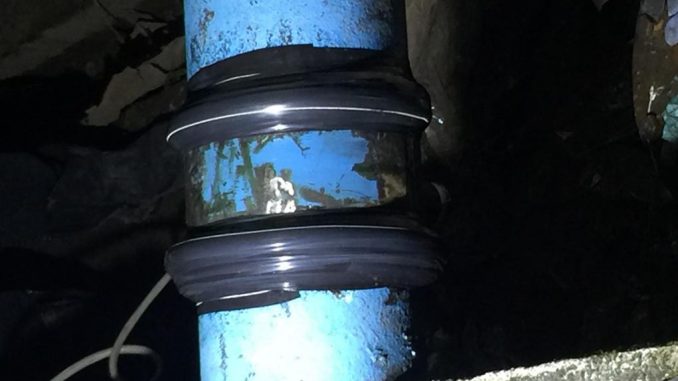
When faced with the challenge of fixing a leaking pipe quickly and easily, two products normally dominate the debate over which is best for the job: epoxy putty and pipe repair tape.
One is a repair compound that hardens in cracks and holes to seal them. The other is a waterproof repair tape that you wrap around a leaking pipe, where it will self-fuse to form a solid rubber band over the leak area.
Two quite different materials, so the confusion surrounding which one to use is often understandable. It does not need to be though, as knowing when to use which product is a lot more straightforward than you might think.
Use epoxy putty to repair leaking pipes where pressure CAN be turned off
When you buy epoxy putty, it starts out as a soft material which is clay-like in consistency. It will either come in two separate parts or as a preformatted stick in which the two components are combined, one on the outside and one on the inside.
As you mix the two parts together, a reaction takes place and it begins to harden. Whilst this happens, you can push it into cracks and holes to fill them. By the time the putty has cured, it will have formed material stronger than concrete. No water is getting past that.
The downside to epoxy putty is that it needs time to work. Depending on the putty which you purchase, that could be as little as five minutes or as long as a couple of hours.
Whatever the work time, epoxy putty will not be able to cure effectively if there is still water flowing through the pipe. Any sort of live leak with pressure and you will struggle to get an effective repair.
Which is why epoxy putty is best suited to fixing a leaking pipe when pressure can be turned off.
Use pipe repair tape to fix leaking pipes where pressure CANNOT be turned off
It is not always possible to turn off water pressure to carry out an emergency pipe repair. In domestic settings, you might not be able to locate the stopcock or it might be so badly rusted up or damaged that it no longer works.
For industrial users, it is often impractical to turn pressure off as it can lead to entire sites having to be shutdown. Isolating burst pipes to carry out a repair is even more troublesome on the public water network; we know of one leaking water main so important that it was allowed to leak for 15 years rather than supply being interrupted for a repair or replacement to be carried out.
When this is the case, then you turn to pipe repair tape for fixing the leaking pipe. The best pipe repair tapes are made from self-fusing silicone and depending on the number of rolls used and the width of the tape, can resist pressure up to 30 bar. For some context, mains water pressure in a domestic home is typically between two and six bar.
Even with water gushing from the leak, pipe repair tape can be anchored next to the damaged area and wrapped across to cover the crack or hole. As you wrap, it will amalgamate to form a solid rubber band, completely sealing the leak.
Turn the repair permanent with a resin-soaked pipe repair bandage
Although repairs carried out with epoxy putty or pipe repair tape are both long lasting, they are not guaranteed to be permanent. In reality, they just allow you to temporarily stop a pipe from leaking before seeking a permanent repair or replacement.
There is way to turn a repair carried out with epoxy putty or pipe burst tape into one that will stand the test of the time – by combining the initial sealing material with a pipe repair bandage.
Pipe repair bandages are resin-soaked wraps which are water-activated. They can be wrapped over the initial repair material and smoothed down, after which they will cure to form a rock-hard, impact-resistant layer.
Once set, this protective covering will prevent anything from damaging the tape or the epoxy putty, negating the need for future reinforcement of the repair or replacement of the pipe.

Leave a Reply